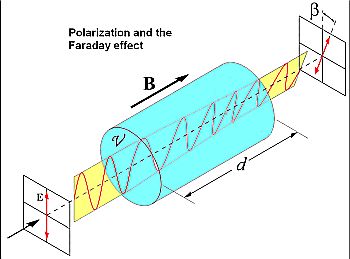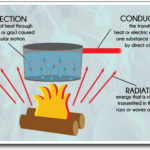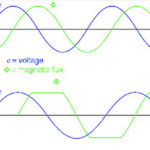Michael Faraday is probably best known for his law of induction. But he also discovered the Faraday Effect in 1845 which states that light and electromagnetism are related phenomena. Faraday asserted that, in fact, light is a form of electromagnetism, anticipating James Clerk Maxwell by nearly two decades. Faraday stated that when a solid or liquid is placed in a uniform magnetic field and a beam of polarized light is passed through it in the direction parallel to the lines of force, the transmitted light is still polarized but the plane of polarization is rotated by an angle proportional to the field intensity. This is why the pixel image in a flat-screen LCD can exhibit not just black and white, but also gradients and indeed shades of color throughout the visual spectrum. The Faraday effect, strictly speaking, is the optical effect of this polarized beam rotation.
The Faraday effect is also known as the magneto-optic effect. It happens in some transparent materials exposed to a magnetic field. The effect happens in materials that exhibit a property known as chirality (and sometimes dubbed handedness). Chiral objects differ from non-chiral objects in that the former are different from their mirror images while the latter are not. A plain metal rod is non-chiral. A threaded rod is chiral, because it differs from its mirror image. The thread rotation is reversed. Similarly, superimposing your right hand over your left hand does not give the same image as either of the two hands by themselves.
Circular polarized light resembles the threaded rod – it is chiral. This is the basis for the liquid-crystal display (LCD) used in flat-screen TVs and computer monitors. Backlight from an LED array passes through two polarized filters the size of the screen. One is composed of liquid crystals, which are chiral. The other is a conventional polarizing filter with closely-spaced lines. When an electromagnetic field is applied to the assembly, the cells in the chiral filter rotate while the non-chiral cells do not. Thus, on a pixel-by-pixel basis, the cell in conjunction with its mate in the other array may or may not filter the light, forming the image on the screen. Accordingly, we can say that Faraday laid the basis for flat-screen technology, although he certainly did not foresee it.
 Another name for the Faraday effect is Faraday rotation. The Faraday effect produces a polarized light rotation that is proportional to the electromagnetic field. The requirements are the magnetic field and the magnetically-active transparent chiral material. The fact that left and right circularly-polarized light waves propagate at different speeds due to the dimensions of the transmitting solid (or liquid) makes this magneto-optic effect possible. This is known as circular birefringence.
Another name for the Faraday effect is Faraday rotation. The Faraday effect produces a polarized light rotation that is proportional to the electromagnetic field. The requirements are the magnetic field and the magnetically-active transparent chiral material. The fact that left and right circularly-polarized light waves propagate at different speeds due to the dimensions of the transmitting solid (or liquid) makes this magneto-optic effect possible. This is known as circular birefringence.
There are a number of YouTube videos that demonstrate the Faraday effect. The usual experimental apparatus generally includes a polarizer often taped to the bottom of a glass beaker holding olive oil. The beaker of olive oil is placed in the bore of a solenoid coil. A second polarizer oriented 90° away from the first goes on the other end of the beaker. Then a light source is shined through the two polarizers and the olive oil in the beaker. The light source is often a laser, but some YouTubers use something as simple as a flashlight on an iPhone. The solenoid coil is connected to a dc power supply to generate a magnetic field within the olive oil in the beaker (usually in the 50 mT range). The point of using olive oil is to send the light through a denser medium so the effect is more visible to the naked eye. In less dense media such as air, the difference in intensity caused by the magnetic rotation will be less pronounced. Toggling the toroid power supply on and off causes a change in brightness through the second polarizer as the magnetic field appears and disappears.
Another way to see the Faraday effect is to send the light beam through a body of water sitting between the two polarizers, then bring a bar magnet close to the light beam as it passes between the two polarizers. When the magnetic field of the magnet is in the direction of light travel, the rotation of the light beam through the media will be more pronounced than when the magnet’s field is orthogonal to the axis of the two polarizers.
Mathematically, the state of polarization rotates in proportion to the applied longitudinal magnetic field according to β =VBd where β is the angle of rotation (in radians), B is the magnetic flux density in the direction of propagation (in Teslas), d is the length of the path (in meters) where the light and magnetic field interact, and V is the Verdet constant for the material, basically the strength of the Faraday effect for that particular material. This empirical proportionality constant (in units of radians per tesla per meter, rad/(T·m)) varies with wavelength and temperature.
We can now contrast the Faraday effect with Faraday’s law of induction. It predicts how a magnetic field will interact with an electric circuit to produce an electromotive force (i.e. voltage) due to a phenomenon known as electromagnetic induction. Faraday’s law says the induced voltage is equal to the rate of change of magnetic flux with respect to time. The basic equation is V = – ΔΦb/Δt where Φb = magnetic flux. The direction of the electromotive force is given by Lenz’s law, basically, the direction of the electric current induced in a conductor by a changing magnetic field is such that the magnetic field created by the induced current opposes changes in the initial magnetic field.
You won’t find many quack-science videos on YouTube about the Faraday effect. Unfortunately, that is not the case for Faraday’s law of induction. It’s easy to locate videos claiming Faraday’s induction law leads to free energy sources. Several involve connecting a motor to a generator, starting the motor, and then claim the motor alone powers the generator to somehow generate extra energy that can power external loads like air fans. Another video we noticed claims to power a light bulb from a coil of wire on which sits a stationary magnet–no movement required!
Needless to say, viewers who try to duplicate these results with their own experiments are destined to be disappointed.




